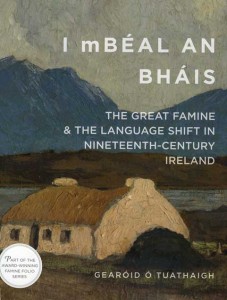I mBÉAL AN BHÁIS: THE GREAT FAMINE AND The LANGUAGE SHIFT IN NINETEENTH-CENTURY IRELAND
Published in Book Reviews, Issue 1 (January/February 2016), Reviews, Volume 24GEARÓID Ó TUATHAIGH
Quinnipiac University Press and Cork University Press
€11.95/£9.95
ISBN 9780990468677
Reviewed by Proinsias Ó Drisceoil

Neo-liberal notions of consumer choice may have influenced a tendency to attribute the shift from Irish to English as the dominant spoken language in Ireland to rational personal convenience, but what the author of this brief study of the process describes as being, ‘by European standards, a remarkable historical event’ was, he argues, not a consequence of choice but of conquest, the exercise of power and the creation of a hegemony among Irish Catholics which had Anglicisation at its core:
‘What exactly, then, did a pragmatic choice mean in the historical context under consideration? A choice where Irish signified the past, stagnation, backwardness, an incapacity to advance, an incapacity to negotiate the law, authority, the state and its apparatuses, the expanding civic space (and, increasingly, the formal institutional world of religious worship, duty, observance); and English signified competence, access to the future, opportunity, advancement, progress, the possibility of participation, and mobility—social as well as geographical.’
While the book’s title might suggest a specific focus on the mid-nineteenth century, Ó Tuathaigh instead analyses the issue across la longue durée, beginning with the sixteenth-century conquest and proceeding through the decimation of native aristocratic leadership to the gradual immiseration of the broad mass of speakers as the language lost all institutional support and expression.
Joep Leerssen’s argument, deriving from Habermas, that Irish lacked a ‘public sphere’ comparable to that occupied by English is subjected here to sustained critique; while the binary ‘Hidden Ireland, Public Sphere’ thesis is deemed to have been ‘overly schematic’, it is fair to say that Leerssen’s postulation emerges more plausibly from this than from many recent studies. Ó Tuathaigh identifies the Catholic Church as an institution critical to language change. Although led by an élite sharing similar ethnic origins to the speakers of Irish, the church effectively excluded Irish from its main domains, particularly after Maynooth College had supplanted Continental Irish colleges, where the language had a higher status than its largely token presence in the Maynooth curriculum. The church hierarchy as the central committee of the Catholic bourgeoisie endorsed the language choice of the latter to the exclusion of Irish; the adoption of similar attitudes by the Irish-speaking poor inevitably followed, however slowly, part of a shift which ‘was already accelerating in the three decades before the founding of the “National” schools in 1831’.
This study is a brief one (part of the strikingly attractive standard-format Famine Folio Series), leaving little room for international comparisons, but a comparison with the fate of Gaelic in Scotland might have been illuminating. Scottish Presbyterianism—and the Free Church in particular—readily adopted Gaelic as the medium of sermons, catechisms, metrical psalms, religious tracts and the vernacular Bible, offering in the process a degree of institutional support to Scottish Gaelic that offset its neglect by a state that saw Gaelic as an obstacle to enlightenment. This was a period in Scotland when nationalist sentiment found little articulation, and the fact that Gaelic managed to survive for so long serves to underline the extent to which nineteenth-century Irish nationalism was of little value to the language. Indeed, as this book demonstrates, nationalist movements, whether constitutional or revolutionary, regarded the language with indifference and were, indeed, active agents of language decline, spreading the use of English in Irish-speaking areas and drawing them into the Anglicising processes of political and social modernisation.
Ó Tuathaigh’s invocation of la longue durée makes the Famine a significant halt rather than a final destination, but he places particular emphasis on its decimation of the rural underclass, the principal speakers of Irish. This and concomitant emigration are identified as key factors determining the accelerated decline of the language. Interestingly, he shows that emigration from the west of Ireland—where Irish was strongest—only overtook emigration from the rest of the country in the final quarter of the nineteenth century. These emigrants were escaping a language that the author, with characteristic elegance, characterises as being ‘without transactional value’, one which few could read and in which there was little to read in any event beyond literary manuscripts; this, as important research by Niall Ó Ciosáin demonstrates, was in sharp contrast to the active promotion of print culture by the Catholic Church among speakers of Breton. An attitude among antiquarians and scholars that characterised Irish as being of little contemporary relevance helped the language on its way to sentimentalised obsolescence.
Ó Tuathaigh, however, offers its due place to the barely noticed emergence of the concept of language revival through projects such as the publication of learning aids by the Belfast-based Cuideacht Gaedhilge Uladh, founded in 1830, or the publication over seven issues of Richard D’Alton’s tiny paper An Fíor-Éireannach in Tipperary town in 1862. Nevertheless, such publications (as well as many of the manuscripts produced in the nineteenth century) assume a prior knowledge of English among their readers, a reasonable assumption but one indicating the ancillary status of Irish as a written language. It was only with the establishment of the Society for the Preservation of the Irish Language in 1876 that language revival began to take a structured form—but as Ó Tuathaigh ruefully remarks, ‘it was very late in the day’.
Proinsias Ó Drisceoil was a contributor to the New Oxford Dictionary of National Biography and the Encyclopedia of Ireland and is a former editor of the Tipperary Historical Journal.
















